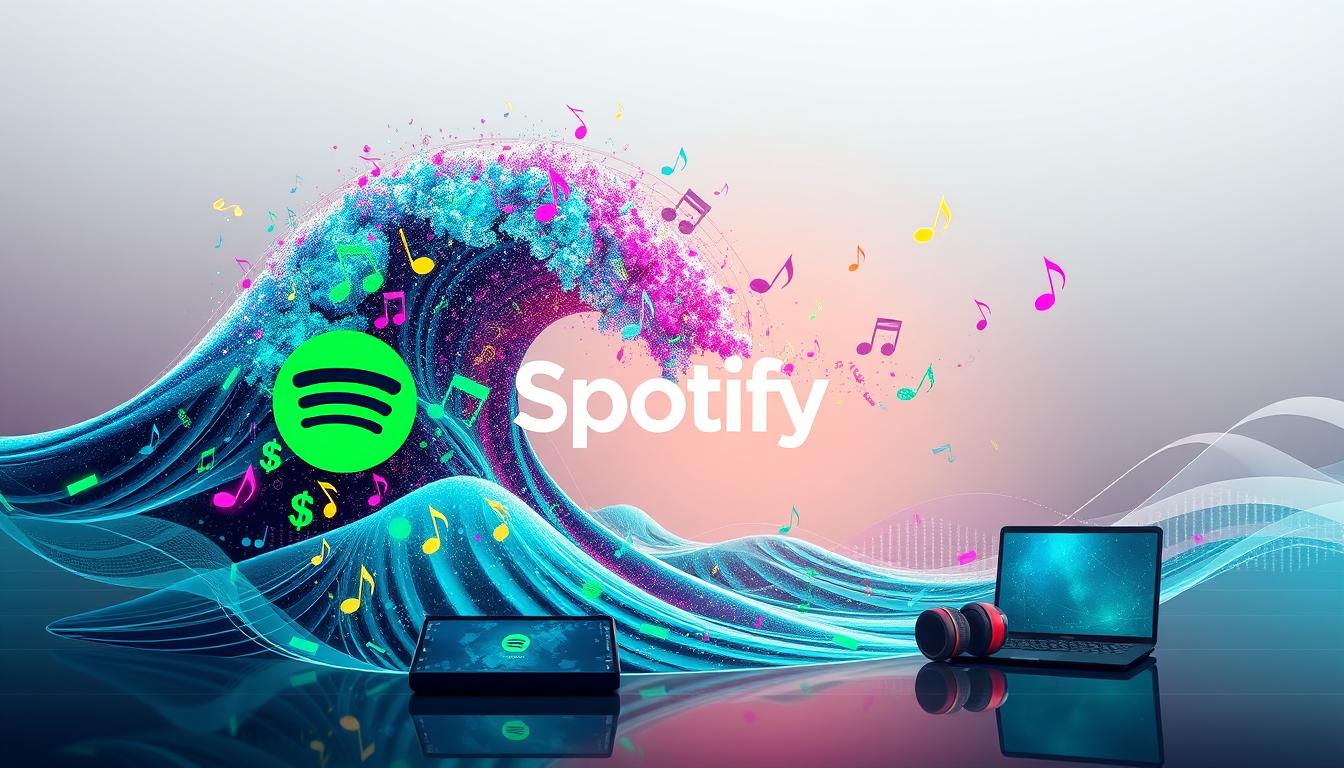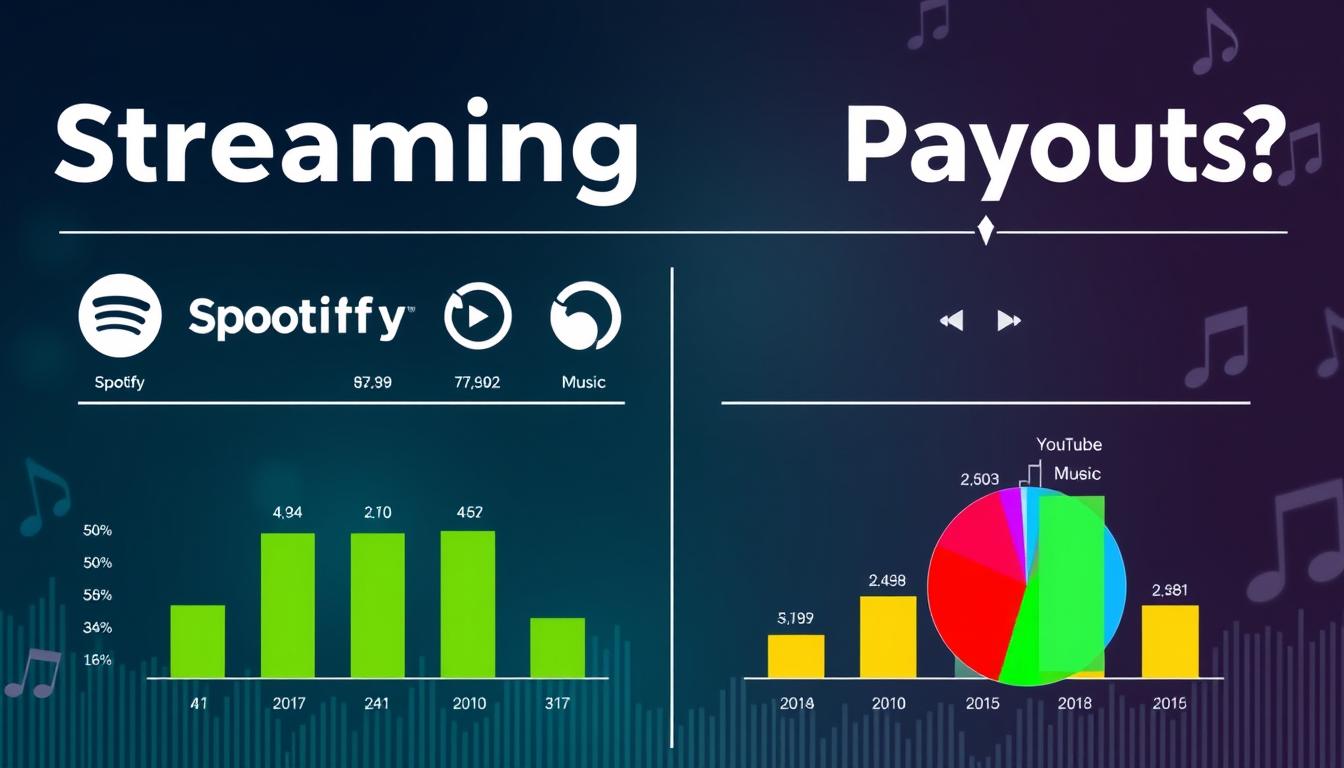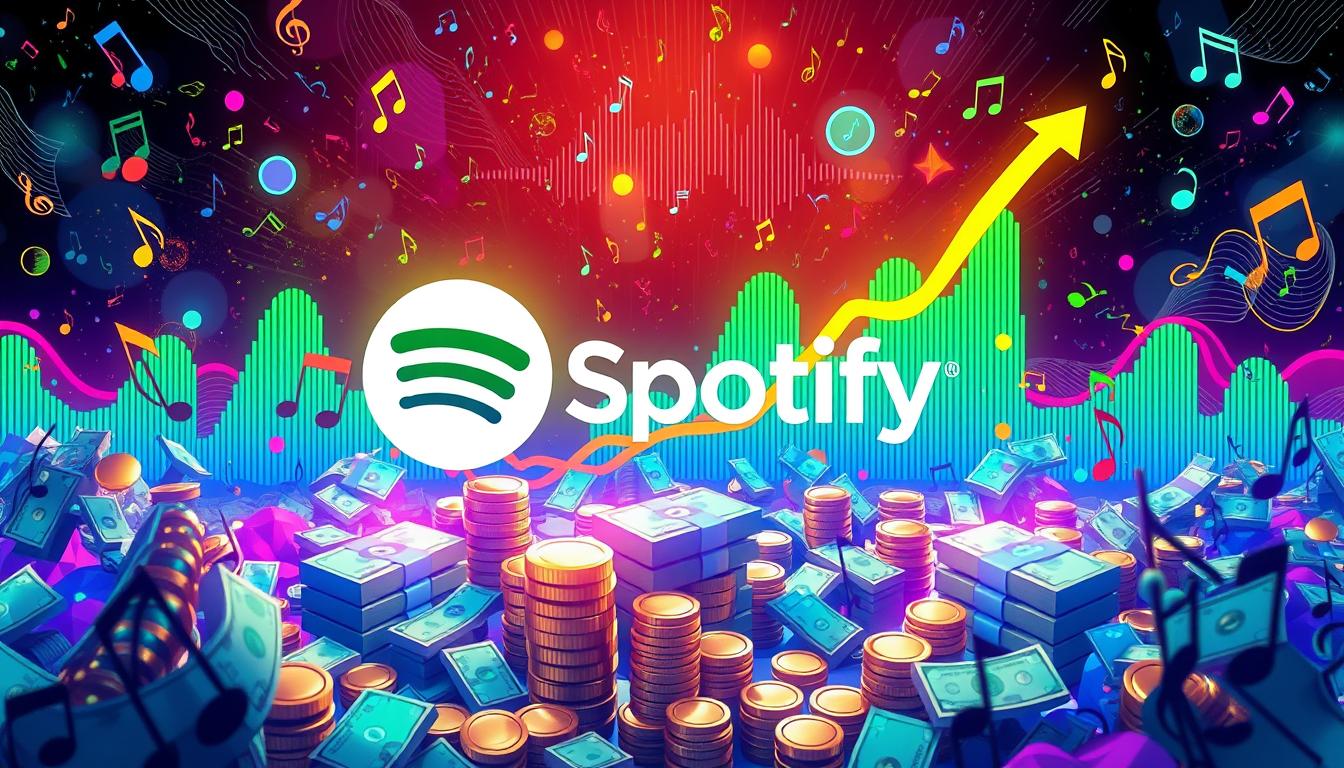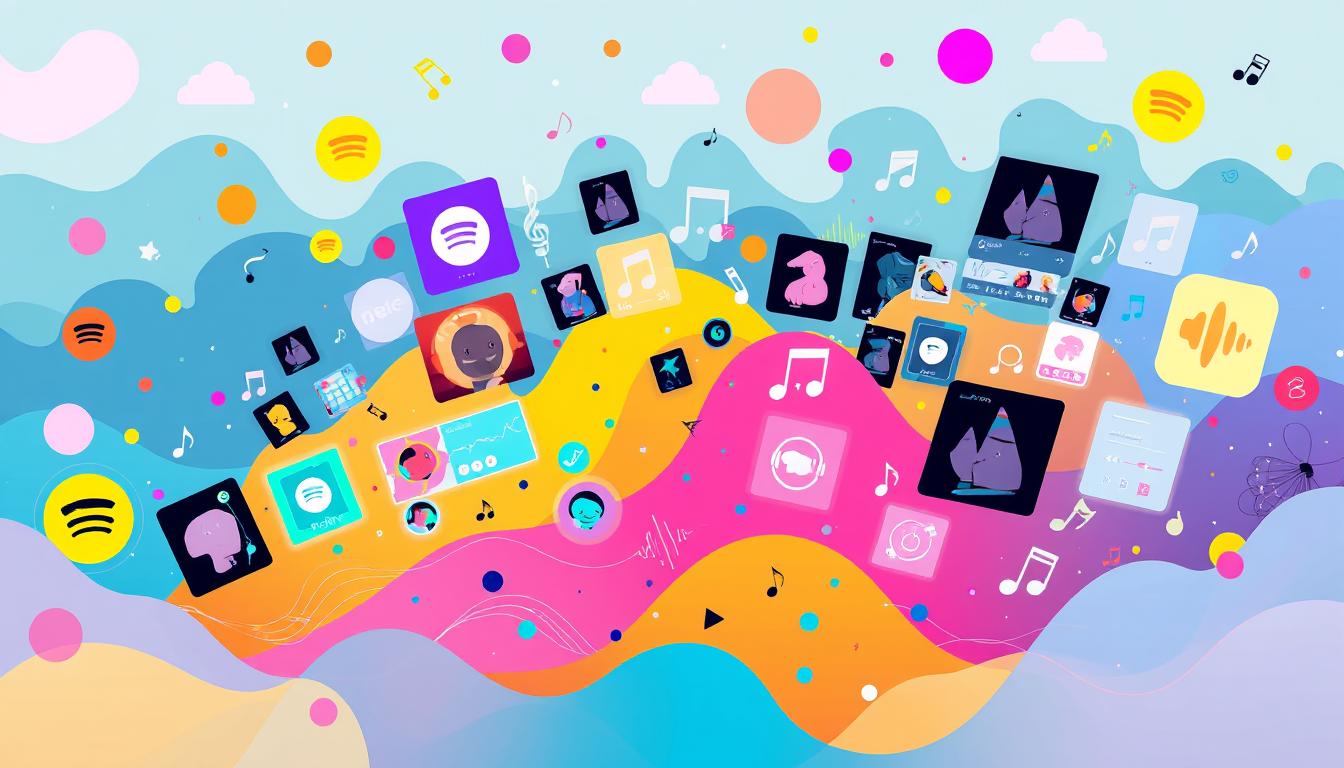How Much Money Is 46 Billion Streams on Spotify?
In the music streaming world, numbers can be huge. Spotify, the top player, has hit 46 billion streams. People often ask: “How much money is that?” The answer is not simple.
Brian Eno, a famous musician and producer, once said, “The music industry is a unique business, in that you’re trying to sell a product that doesn’t really exist.” This is true when looking at Spotify’s payment system. Many things affect how much artists make.
Key Takeaways
- Spotify’s payment structure is complex, with a base rate per stream and various factors that affect overall earnings.
- Regional payment variations, premium vs. free listeners, and the time period of streams can all impact the revenue generated from 46 billion streams.
- Understanding Spotify’s revenue distribution model, which includes artist share, platform share, record label cuts, and publishing rights payments, is crucial.
- Comparing Spotify payouts to other streaming platforms provides valuable context for assessing the potential earnings from 46 billion streams.
- Maximizing Spotify earnings requires considering factors like playlists, algorithms, and the evolving nature of the platform’s payment rates.
Understanding Spotify’s Payment Structure
Spotify’s payment structure is key to understanding the earnings from 46 billion streams. The payout rate per stream is a major factor for artists and rights holders.
Base Rate Per Stream
Spotify pays around $0.003 to $0.005 per stream. This means artists or rights holders get $3 to $5 for every 1,000 streams. But, this rate can change based on several factors.
Factors Affecting Payment Rates
- Subscription type: Payments are higher for premium subscribers than free users.
- Geographical location: Rates vary by country or region where streams come from.
- Licensing agreements: Deals with labels, publishers, and others can affect payouts.
Regional Payment Variations
Spotify’s payouts differ by region. For example, in the U.S., it’s about $0.004 per stream. In some European countries, it’s up to $0.006. These differences depend on living costs, consumer spending, and licensing agreements.
Artists and industry pros need to understand Spotify’s complex payment structure. Knowing the base rates, factors affecting payouts, and regional differences helps them make better decisions. This way, they can maximize their earnings on the platform.
How Much Money Is 46 Billion Streams on Spotify
Spotify is a big name in music streaming. It’s a key way for artists and labels to make money. With 46 billion streams, many wonder how much cash that is. To figure it out, we look at Spotify’s payment system and what affects how much artists get paid.
Spotify pays artists about $0.004 for each stream. But, this amount can change. It depends on the listener’s plan, where they are, and when they listened.
| Metric | Estimated Value |
|---|---|
| Base Rate per Stream | $0.004 |
| Total Streams | 46 billion |
| Estimated Payout | $184 million |
With 46 billion streams and a base rate of $0.004, the total payout is about $184 million. But, this is just an estimate. The real amount can change based on different factors.
As Spotify’s payouts grow, knowing how they work is key. It’s important for artists and the music industry to understand this.
Breaking Down Spotify’s Revenue Distribution Model
Spotify’s way of paying out money is quite complex. It shows how much artists, record labels, and others get from each stream. Knowing this is key for artists wanting to make more money on Spotify.
When a song streams on Spotify, the money is split. Artists usually get about 70% of it. The other 30% goes to Spotify to cover costs and make profits.
Record Label Cuts
Many artists work with record labels. This means they have to share some of their Spotify money with the label. Labels often take 15-30% of what artists earn from streams.
Publishing Rights Payments
Spotify also pays those who own the rights to songs. This includes songwriters and music publishers. They get around 10-15% of the total money made from streams.
| Revenue Split | Percentage |
|---|---|
| Artist Share | ~70% |
| Spotify Platform Share | ~30% |
| Record Label Cut | 15-30% |
| Publishing Rights Payments | 10-15% |
Understanding Spotify’s revenue model helps artists and others in the music industry. It makes it easier to deal with music streaming royalties and Spotify’s compensation structure.
Comparing Spotify Payouts to Other Streaming Platforms
The music industry has always been a hot topic. Spotify is a big name in streaming, but how does it compare to others? We’ll look at Apple Music, Amazon Music, and Tidal too.
Spotify pays artists based on how many times their songs are streamed. But Apple Music and Tidal give artists a bigger share of what they make. This is a big difference.
| Streaming Platform | Average Payout per Stream (USD) | Revenue Share for Artists |
|---|---|---|
| Spotify | $0.0033 – $0.0054 | Approximately 65-70% |
| Apple Music | $0.0056 – $0.0078 | Approximately 70-80% |
| Amazon Music | $0.0040 – $0.0059 | Approximately 65-75% |
| Tidal | $0.0125 – $0.0170 | Approximately 75-85% |
These differences can really affect how much money artists make. Spotify has lots of users, but pays less per stream. This means artists might earn less, especially if they’re not well-known. On the other hand, Tidal might pay more, making it a better choice for some artists.
Keep in mind, these numbers are just estimates. They can change based on many things. Like the artist’s deal with their record label, or how popular their music is on each platform.
Factors That Impact Streaming Revenue
Artists in the music streaming world need to know how different things affect their Spotify earnings. Things like the type of listener, where the stream comes from, and when it happens all play a part. These factors can change how much an artist makes from each stream.
Premium vs. Free Listeners
The type of listener is a big factor in Spotify’s payout rate per stream. Premium users, who pay for the service, help artists earn more. On the other hand, free users, who listen to ads, pay less per stream.
Geographical Location of Streams
Where a stream comes from also matters a lot. Some places pay more for streams because of the cost of living and how much people spend. Knowing where your fans are and planning your content for those places can help you earn more.
Time Period of Streams
When streams happen can also affect earnings. Some times or events might get more people listening, which means more money for artists. Planning your releases to match when people are most likely to listen can help you earn more.
Knowing about these factors can help artists make better choices. They can plan their content and releases better. This way, they can earn more from Spotify.
Real-World Examples of Major Artists’ Spotify Earnings
The idea of 46 billion Spotify streams might seem huge. But, looking at top artists’ earnings gives a clearer picture. Let’s check out some examples that show how much money artists can make from such huge stream counts.
Ed Sheeran is one of the most streamed artists on Spotify. His hit “Shape of You” has over 3 billion streams. This means he could have made around $3 million. On the other hand, Drake’s “God’s Plan” has over 1.6 billion streams. This could have earned him over $1.6 million.
These numbers are impressive, but they’re small compared to what 46 billion streams could bring. If we assume an average payout of $0.01 per stream, the earnings could reach about $460 million.
“The sheer scale of 46 billion Spotify streams is mind-boggling. It’s a testament to the platform’s global reach and the insatiable demand for music in the digital age.”
But, these figures are just estimates. Spotify’s payment system is complex. It depends on many things like listener demographics, ad revenue, and record label deals.
Still, these examples show the big money potential for artists with billions of Spotify streams. As Spotify remains a top music streaming site, artists need to understand how to make the most from their streams.
The Evolution of Spotify’s Payment Rates
Spotify has changed how it pays artists over the years. This change shows the platform’s effort to keep up with the music streaming world. By looking at past changes and future plans, we can understand how Spotify pays creators.
Historical Payment Changes
Since it started, Spotify has updated its payment system many times. In the beginning, artists got very little for each stream. But, Spotify has slowly raised what it pays per stream to make it fairer for artists.
Recently, Spotify has made its payments better in some ways. It pays more for certain music types, playlists, and exclusive content. These changes help artists do well on the platform.
Future Payment Projections
Spotify is still the top streaming service, and experts think it will keep making changes. New streaming services, changing tastes, and music laws might make Spotify rethink how it pays artists. This could lead to new ways to make sure artists get a fair share.
There’s also talk about paying artists based on how much each user listens. This could change how Spotify pays out money. As Spotify grows, artists and others in the music world will watch these changes closely.
| Year | Spotify’s Average Payout per Stream | Percentage Change |
|---|---|---|
| 2015 | $0.00437 | – |
| 2017 | $0.00531 | +21.5% |
| 2019 | $0.00623 | +17.3% |
| 2021 | $0.00682 | +9.5% |
As the music streaming world keeps changing, Spotify’s fair pay for artists is key. This will help Spotify stay successful and keep attracting great artists.
How Artists Can Maximize Their Spotify Earnings
As an artist, understanding spotify streaming income and royalty calculation for streams can be tough. But, there are ways to maximize your Spotify artist earnings. You can also get your music to more people.
Start by increasing your stream count. Get your fans to make playlists with your songs. Also, share your music on social media. Use Spotify’s tools, like Spotify for Artists, to improve your profile and find new listeners.
- Encourage fan-created playlists featuring your music
- Actively promote your music on social media
- Utilize Spotify’s promotional tools, like Spotify for Artists
Understanding playlist placement is key to maximizing Spotify earnings. Being on popular playlists can really help your streams and money. Try to get on playlists, both on Spotify and other sites. Make sure your music fits what the curators like.
| Playlist Type | Potential Impact on Earnings |
|---|---|
| Spotify-Curated Playlists | High |
| User-Generated Playlists | Moderate |
| Third-Party Playlists | Varying |
Don’t just focus on Spotify streaming income. Look at other places like Apple Music, Amazon Music, and YouTube. Also, think about live shows, selling merchandise, and other music-related ways to make money. This can help make your career more stable.
By using these tips, artists can make the most of Spotify’s streaming model. This can lead to more money and a better career on Spotify.
Spotify is the top music streaming service worldwide. It has a large user base and a changing way of making money. This makes it a big player in the spotify music streaming revenue and streaming service payouts world.
Streaming Market Demographics
Spotify attracts people of all ages and backgrounds. It offers music for everyone, which helps it make money and stay popular.
- Spotify has over 365 million monthly users, with many being 18-34 years old.
- It’s big in the US, Europe, and Latin America, showing it’s loved worldwide.
- Spotify Premium has over 165 million subscribers, which is a big money maker.
Platform Growth Statistics
Spotify has grown a lot and is now a top name in music streaming. Its growth shows it’s always finding new ways to make money and stay ahead.
- Spotify’s user base grows by over 20% every year.
- Its premium subscribers are growing faster than its total users, helping its spotify revenue model.
- Spotify leads the music streaming market with a 31% share.
As Spotify keeps growing, it will keep shaping the music streaming world. Its influence on spotify music streaming revenue and streaming service payouts will be key for years to come.
The Impact of Playlists and Algorithms on Earnings
In the world of Spotify streaming, playlists and algorithms are very powerful. They can greatly affect how much money an artist makes. This is especially true for their Spotify streaming income and earnings from the spotify royalties calculator.
Playlists are key to getting more people to listen to artists. Being on a popular playlist can really help an artist’s Spotify’s payout rate per stream. This is because more people will listen to their music, leading to more streams.
But, Spotify’s algorithms change often. Artists need to keep their music and marketing fresh to stay noticed. By understanding these algorithms and adjusting their strategies, artists can get more chances to be on playlists.
Artists who get good at making playlists work for them can see a big increase in their Spotify streaming income. This can lead to more money overall.
“The algorithm is the new gatekeeper in the music industry, and artists who learn to navigate it can unlock unprecedented success on Spotify.”
As playlists and algorithms become more important, artists need to keep up. They should learn about Spotify’s changes and adjust their plans. This way, they can do well in the long run and make more money from the Spotify royalties calculator.
Conclusion
In this article, we’ve looked into Spotify’s music streaming revenue. We’ve uncovered the details behind the estimated earnings from 46 billion streams. We’ve learned about Spotify’s payment structure and what affects artist earnings.
The number of streams might look big, but the actual money made can change a lot. This depends on who’s listening, where they are, and their subscription type. Artists and industry folks need to understand this to make more money on Spotify.
The music world is moving towards digital, making it key to know about spotify music streaming revenue and spotify artist earnings. Artists, labels, and others need to stay informed. This way, they can face challenges and grab opportunities in the how much money is 46 billion streams on spotify world.
FAQ
How much money is 46 billion streams on Spotify?
The money from 46 billion streams on Spotify varies a lot. This is because Spotify’s payment system is complex. The base rate per stream is about $0.004, but it can change. This depends on things like the subscription type, where the stream is from, and the artist’s record label deal.
In the end, how much money artists make from 46 billion streams depends on many factors. It’s likely to be hundreds of millions to over a billion dollars.
What is Spotify’s payment structure?
Spotify’s payment system is complex. It has a base rate per stream, usually around $0.004. But this rate can change based on several things.
These include the type of subscription, where the stream is from, and the artist’s record label deal. Spotify also shares money with record labels, publishers, and others. So, artists don’t get the full $0.004 per stream.
What factors affect Spotify’s payout rates?
Several things can change how much Spotify pays artists. The type of subscription and where the stream is from matter a lot. Also, the artist’s record label deal can affect payouts.
Premium subscribers get paid more per stream than free users. And payouts can differ based on the artist’s location due to market conditions and licensing deals.
How does Spotify’s revenue distribution model work?
Spotify shares its streaming revenue with many people. Artists get a part of the money, but not all of it. The rest goes to Spotify, record labels, and publishing rights holders.
The exact percentages artists get can vary. It depends on their contract and other factors. But artists usually don’t get 100% of the streaming revenue from their music.
How do Spotify’s payouts compare to other streaming platforms?
Spotify’s payouts are similar to other big streaming services like Apple Music and Amazon Music. But there can be small differences.
Things like subscription prices, who listens, and licensing deals can affect payouts. So, payouts can vary between services.
What factors impact an artist’s streaming revenue on Spotify?
Several things can change how much an artist makes on Spotify. The mix of premium and free listeners matters. So does where the streams are from and when they happen.
Premium subscribers pay more per stream. And streams from certain places might get different rates because of market conditions and licensing deals.
How have Spotify’s payment rates changed over time?
Spotify’s payment rates have changed since it started. The base rate per stream has gone up and down over the years. Spotify has also changed how it shares revenue with artists.
As the music streaming world keeps changing, Spotify’s payment system will likely change too. It will adapt to new market conditions.
How can artists maximize their Spotify earnings?
Artists can do several things to make more money on Spotify. They can try to get more streams, get on popular playlists, and use Spotify’s tools to promote their music.
Keeping their music high quality, connecting with fans, and understanding Spotify’s algorithms can help. These actions can increase an artist’s streaming revenue.
Spotify’s big size and global reach can really help artists’ earnings. As the biggest music streaming service, Spotify offers a huge chance for artists to make money.
Knowing how big Spotify is and how it’s growing can help artists estimate their earnings. It gives them a better idea of the potential from lots of streams.
How do Spotify’s playlists and algorithms affect artist earnings?
Spotify’s playlists and algorithms can greatly affect an artist’s earnings. Being on popular playlists can really boost an artist’s stream counts and earnings.
Spotify’s algorithms that suggest music to users can also help. They can make an artist more visible and increase their stream counts, leading to more money.





